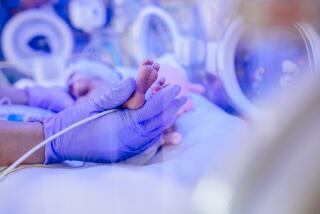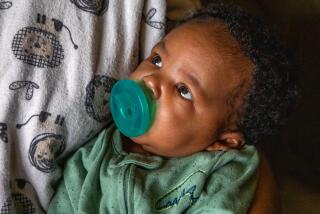How Parents Can Reduce Risk of SIDS
- Share via
Imagine how devastating it would be if your baby died suddenly during sleep, without any warning of illness. Each year, about 3,000 babies die each year because of Sudden Infant Death Syndrome.
Most SIDS victims seem perfectly healthy, then die unexpectedly at home while they are sleeping, without any signs of distress, such as crying or struggling. SIDS is the leading cause of death in the United States among infants between 1 month and 1 year old. Until just a few years ago, the cause of this syndrome was a mystery.
Recent studies suggest, however, that some infants who die suddenly have an abnormality in the part of their brains that controls breathing during sleep. Researchers also have identified several groups of infants who are at increased risk of sudden death.
SIDS is more likely to occur in babies who are born prematurely or with low birth weight, and in families where another child has died as a result of SIDS. Sudden death also occurs more commonly among infants born to young mothers (under 20 years old) and to babies who are exposed to secondhand smoke at home.
*
Many cases of SIDS may actually be attributable to accidental suffocation in the crib, because the risk of sudden death is greater among babies who sleep on their stomachs. It is believed that their faces may become trapped in soft bedding or pillows, which blocks their access to fresh air and oxygen.
While there is no certain way to prevent SIDS, a parent can do several things to reduce a child’s risk:
* Place your baby in the supine position (lying on the back) while sleeping. (Side-sleeping is not considered as safe because some infants will roll over and end up on their stomachs.)
* When your baby is awake, let the child spend some time on the stomach to promote normal neck and back strength. While on their stomachs, babies should be closely supervised.
* Use a firm mattress and remove all soft surfaces from your infant’s crib. Pillows, bumpers and soft mattresses have the potential for trapping air and suffocating the baby. Bumpers are only necessary once your baby is able to turn over and should be avoided until then.
* Never allow babies to sleep on soft surfaces, such as pillows, sofa cushions or water beds.
* Do not smoke during pregnancy. Pregnant women who smoke increase their risk of delivering prematurely and having babies with low birth weight. Both increase an infant’s risk for sudden death.
* Keep your baby away from secondhand smoke. Exposure doubles a baby’s chance of sudden death. The risk grows with each additional smoker in the household and with the number of cigarettes smoked each day in the home.
* Breast-feed your baby. Breast-feeding appears to reduce the risk of SIDS.
* Avoid covering your baby with blankets. If an infant’s face gets trapped in a blanket, suffocation can occur. To keep your sleeping baby warm, maintain the room temperature between 68 and 70 degrees Fahrenheit, and dress the baby in warm pajamas. To avoid overheating, dress the child in clothes similar to what you wear at night.
* Consider using an apnea monitor if your baby is at high risk for SIDS. These special electronic breathing monitors can be used at home to detect when a baby stops breathing. They are recommended only for babies who have a significantly increased risk of SIDS. This includes infants who have experienced one or more severe episodes of apnea, premature infants who are currently experiencing apnea, and babies with two or more siblings who have died of SIDS. Your pediatrician can help you determine when the use of an apnea monitor is appropriate.
(BEGIN TEXT OF INFOBOX / INFOGRAPHIC)
If You Need More SIDS Information
Some other resources: Sudden Infant Death Syndrome Alliance, 1314 Bedford Ave., Suite 210, Baltimore, MD 21208. Phone: (800) 221-SIDS. Or on the Internet: https://www.SIDSalliance.org.
SIDS Foundation of Southern California, P.O. Box 90544, Pasadena, 91109-0544. Or e-mail: SIDSfsc@aol.com.
National SIDS Resource Center, 2070 Chain Bridge Road, Suite 450, Vienna, VA 22181. Phone: (703) 821-8955.






